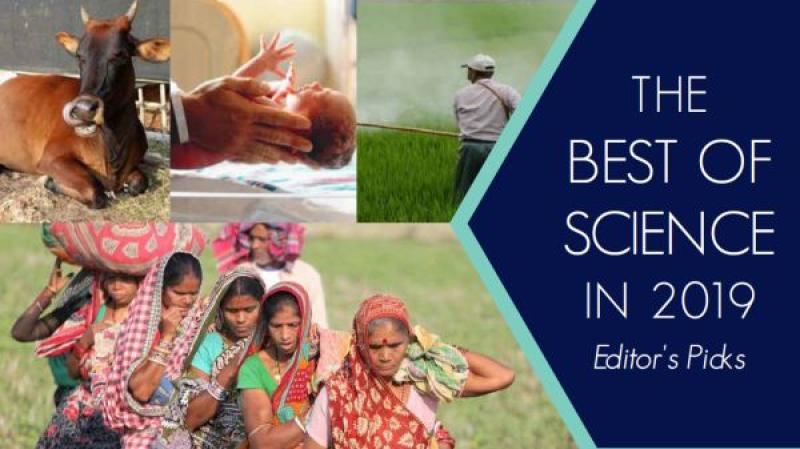
While looking forward to 2020, the editorial team at Research Matters looks back on some of the interesting stories that we published during 2019. There were many interesting ones ranging from the first photograph of a black hole to air pollution in Delhi to using vibrations for painless injections. Here is a list to highlight India's year in science during 2019. This is in no way ranked and the order is just incidental.
1. The tale of a lizard’s stripes and colourful tail
Why this stands out: An increasing number of researchers across India are deciphering how evolution has shaped the survival traits of many living beings around us and this study adds to the body of the knowledge. The writer articulates, through many similar examples, what motion dazzle is and how the lizards have benefitted from this. Lizards are one of the commonly-found reptiles and talking about the interesting aspects of their evolution can intrigue wonder about them.
2. Playing ‘rock-paper-scissors’ with bacteria
Why this stands out: Bacterial strains that are resistant to antibiotics are evolving and becoming commonplace. While scientists are working on more powerful antibiotics, it is also necessary to understand the interplay involved in bacterial colonies, which the study does. In this story, the writer takes you through the competition in bacterial colonies with the analogy of a popular game.
3. Methods of Archimedes and Bhāskara to Help Teaching
Research in pedagogical methods is scarce in India, which has the world's largest population of youngsters. This study takes a look into the work of scholars dating back 2000 years in teaching mathematics to children. The writers of the article build upon the opinions of the researchers by using examples that can demonstrate the principles of teaching discussed by Bhaskara and Archimedes.
4. Majority of deaths among children aged 5–14 years in India preventable, says study
Data visualisation is a tool that can supplement storytelling effectively, and provide the reader with a take-home message that stays for long. This year, some of our stories used visualisation to compare, contrast and build a narrative based on data from the studies. Here is one such story that talks about preventable child deaths in India. The writer uses different types of charts to provide different perspectives with data at hand.
5. Snapped! Here is the first photograph of a black hole
Science reporting, unlike others, provides fewer opportunities to report 'live' and 'as it happens'. Science writers typically pick a study/report, build a narrative around it and present to the readers their stories. However, for the first time, Research Matters tuned in to a live press conference of the world's historic scientific breakthrough--the release of the first photographic evidence of the black hole. While the feat in itself deserves much recognition, our coverage was the first such experiment for us.
6. From bulbuls to hornbills—Why do forests need them all?
With the changing climate and decreasing habitats, birds and animals all over the world are decreasing in numbers, with some dwindling at a rapid pace than others. Often, every species has its place and a distinct role to play. This study talks about the importance of all birds, big and small, in a forest. The writer explains the role of few such species by describing the unique roles they play.
When a story is told by bringing alive characters, it is powerful and gives a personal touch. This was a first attempt at telling a science story by bringing alive characters from the study. The photos that go along with the story helps bring up the topic at hand—the burden of farm labour on women, resulting in malnourishment.
8. India’s polluted air: What lies beyond Delhi?
Air pollution has been a bane for the country in recent years and studies have increasingly started to show the ill effects of the air that we are breathing today. Often, Delhi's plight is in the news, although there are other cities that have higher pollutants in the air. Which are those cities and what kind of pollutants dominate the air there? In this article, the writers not only give you a glimpse of what lies beyond Delhi but also show how badly the air is polluted with graphs.
9. Where did we Indians come from?
This year saw two studies that changed our understanding of the human migration routes into India and in this article, the writer details the new findings and the implications of the same.
10. Bacterial remedy for the toxic pesticide Carbaryl
A study showed that bacteria could help us break down toxic chemicals in pesticides But how? Details are crucial to a good science story and in this one, the writer explains the complex mechanisms involved in the act of bacteria breaking down the chemicals in carbaryl, a commonly used pesticide.
It is a joy for a science writer if he/she can write a story on a study that has been just been published. More so, when there are time and cooperation on her side and this article was a perfect combination of all that!
12. Is the Pradhan Mantri Ujjwala Yojana brightening lives in rural Karnataka?
When welfare schemes are announced, it is prudent to check on the progress of such schemes and to verify if it is reaching the intended beneficiaries. While researchers do various studies to find that out, science writers play a key role in communicating these findings to the masses so they know where their money is going in the guise of such schemes. In this article, the writer tries to do that with the Pradhan Mantri Ujjwala Yojana.
13. India’s iconic Vembanad lake is drowning in microplastics
It is well known how plastic in the oceans is proving to be fatal for aquatic life, but lakes are not far from the ill effects of microplastics. In this story, the writer details how microplastic has been a worry for the Vembanad lake in Kerala, a protected wetland and what effects does this pollution have on the aquatic life.
14. India, an emerging hotspot for antimicrobial resistance in farm animals, finds study
Antimicrobial resistance in humans has been a hot topic lately, and farm animals are also not spared. In this article, the writer talks about how India is emerging as a hotbed for antibiotic resistance in farm animals. This is of concern because these animals are used as food sources and live in close proximity with humans.
15. Vibrations for Painless Injections
Biomimetics, or the act of mimicking from nature, has inspired the design of many things around us today. In this article, the writer adds painless injections to that list, inspired by mosquito bites. The article describes how these nagging bites help in the design of such painless injections by following the pattern of vibrations.





















